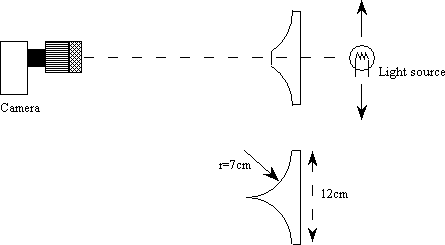Laser and plastic lens with curvature to simulate bending of light by massive object.
What it shows:
Gravitational lensing is caused by the bending of light rays by the gravitational field of an intervening object. The effect is seen with the Sun, but is most spectacular when a whole galaxy acts as a lens to a cosmologically distant object, such as a quasar. Depending on the geometry of the alignment and the structure of the lensing galaxy, the image of the quasar is distorted into two or more distinct images, sweeping arcs or a complete ring. Here we model the effect using refraction through a plastic lens.
figure 1. Schematic illustration of gravitational lensing
How it works:
The gravitational lens of a simple source can be modeled with a 'wineglass base' shaped lens, one whose curvature is circular. We worked two pieces of plexiglass, diameter 12cm, on a lathe with a circular tool bit (p pro name?), with a curvature radius of 7cm. One was brought to a point and the other left with a flat face to simulate an extended source. Figure 2 shows their cross-sections.
figure 2. Cross-sections of lenses and setup layout
Setting it up:
Mount the lens on an optics bench with light source, which can be a small bulb (p specifications) or low power HeNe laser, behind the flat face. The light source should be movable, so that it can be aligned on axis to give a ring image, or off axis to show arcs. Mount the camera on axis with the lens, 1-2 meters away with a zoom so you can show the audience the setup, then move in to concentrate on the image.
Comments:
This demo models the simplest possible lensing geometry. Most real lensing systems give more complex images, because the lensing object is an elliptical or spiral galaxy. See the astronomy literature for more technical details. A couple of objects to look out for are the quasar 0957+561, a double image of one object and the first gravitational lens identified, and MG 1654+1346, an Einstein ring.
References:
F. H. Chaffee, Sci Am 243, 70 (Nov. '80)
J. Higbie, Am. J. Phys. 51, 860 (Sept. '83)
E. L. Turner, Sci Am 259, 54 (Jul. '88)
Sky & Telescope (Apr. '91)
R.J. Adler, W.C. Barber, and M.E. Radar, Am. J. Phys. 63(6), 536 (1995), "Gravitational lenses and plastic simulators"
M. Falbo-Kenkel and J. Lohre, TPT 34, 555-557 (1996). "Simple Gravitational Lens Demonstrations."